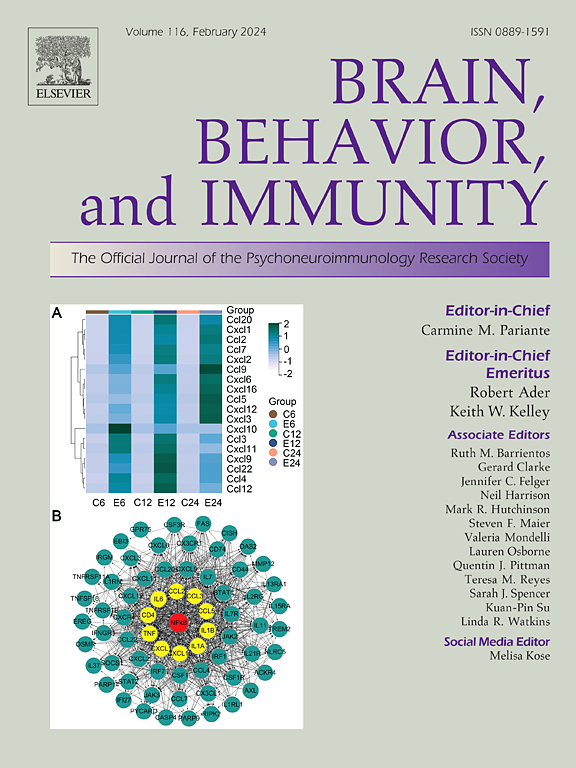Glymphatic function and choroid plexus volume is associated with systemic inflammation and oxidative stress in major depressive disorder
IF 8.8
2区 医学
Q1 IMMUNOLOGY
引用次数: 0
Abstract
Background
Inflammatory processes were recognized as key factors in the pathophysiology of major depressive disorder (MDD). The choroid plexus (ChP) and glymphatic system played central roles in immune interactions between the brain and periphery. However, their specific roles in MDD and their relationship with systemic inflammation and oxidative stress remained unclear.
Methods
This study finally included 665 MDD patients and 338 healthy controls. Clinical data and MRI scans were collected, and some patients also underwent blood routine and biochemical tests. ChP volume was manually segmented, and the diffusion tensor imaging along the perivascular space (DTI-ALPS) index, reflecting glymphatic function, was obtained through the FSL pipeline. The differences in these dices between groups were compared, and their associations with systemic inflammation and oxidative stress were analyzed.
Results
MDD patients showed increased ChP volume (total: d = 0.316, p < 0.001; left: d = 0.317, p < 0.001; right: d = 0.268, p = 0.003) and decreased DTI-ALPS index (d = −0.144, p = 0.022), with a negative correlation between them (ρ = −0.135, p < 0.001). In MDD patients, lower DTI-ALPS index was correlated with higher LHR (ρ = −0.107, p = 0.025) and MHR (ρ = −0.126, p = 0.008). Larger right ChP volume was associated with higher MLR (ρ = 0.107, p = 0.009), SIRI (ρ = 0.086, p = 0.036), PIV (ρ = 0.086, p = 0.036), MHR (ρ = 0.136, p = 0.004), and PHR (ρ = 0.126, p = 0.008), while larger total ChP volume was correlated with higher MHR (ρ = 0.097, p = 0.042) and PHR (ρ = 0.114, p = 0.017).
Conclusion
MDD appeared to be accompanied by an increase in ChP volume and a decrease in glymphatic function, and these changes were related to systemic inflammation and oxidative stress.
重度抑郁症患者淋巴功能和脉络膜丛体积与全身炎症和氧化应激有关
背景:炎症过程被认为是重度抑郁症(MDD)病理生理的关键因素。脉络膜丛(ChP)和淋巴系统在大脑和外周免疫相互作用中起核心作用。然而,它们在MDD中的具体作用及其与全身性炎症和氧化应激的关系尚不清楚。方法本研究最终纳入665例重度抑郁症患者和338例健康对照。收集临床资料和MRI扫描,并对部分患者进行血常规和生化检查。人工分割ChP体积,通过FSL管道获得反映淋巴功能的沿血管周围间隙扩散张量成像(DTI-ALPS)指数。比较各组之间这些指标的差异,并分析其与全身性炎症和氧化应激的关系。结果smdd患者ChP体积增加(总:d = 0.316, p <;0.001;左:d = 0.317, p <;0.001;右:d = 0.268, p = 0.003), DTI-ALPS指数下降(d = - 0.144, p = 0.022),两者呈负相关(ρ = - 0.135, p <;0.001)。MDD患者DTI-ALPS指数越低,LHR越高(ρ = - 0.107, p = 0.025), MHR越高(ρ = - 0.126, p = 0.008)。较大的右侧ChP容积与较高的MLR (ρ = 0.107, p = 0.009)、SIRI (ρ = 0.086, p = 0.036)、PIV (ρ = 0.086, p = 0.036)、MHR (ρ = 0.136, p = 0.004)和PHR (ρ = 0.126, p = 0.008)相关,而较大的总ChP容积与较高的MHR (ρ = 0.097, p = 0.042)和PHR (ρ = 0.114, p = 0.017)相关。结论mdd伴有ChP体积增加和淋巴功能下降,这些变化与全身炎症和氧化应激有关。
本文章由计算机程序翻译,如有差异,请以英文原文为准。
求助全文
约1分钟内获得全文
求助全文
来源期刊
CiteScore
29.60
自引率
2.00%
发文量
290
审稿时长
28 days
期刊介绍:
Established in 1987, Brain, Behavior, and Immunity proudly serves as the official journal of the Psychoneuroimmunology Research Society (PNIRS). This pioneering journal is dedicated to publishing peer-reviewed basic, experimental, and clinical studies that explore the intricate interactions among behavioral, neural, endocrine, and immune systems in both humans and animals.
As an international and interdisciplinary platform, Brain, Behavior, and Immunity focuses on original research spanning neuroscience, immunology, integrative physiology, behavioral biology, psychiatry, psychology, and clinical medicine. The journal is inclusive of research conducted at various levels, including molecular, cellular, social, and whole organism perspectives. With a commitment to efficiency, the journal facilitates online submission and review, ensuring timely publication of experimental results. Manuscripts typically undergo peer review and are returned to authors within 30 days of submission. It's worth noting that Brain, Behavior, and Immunity, published eight times a year, does not impose submission fees or page charges, fostering an open and accessible platform for scientific discourse.

 求助内容:
求助内容: 应助结果提醒方式:
应助结果提醒方式:


